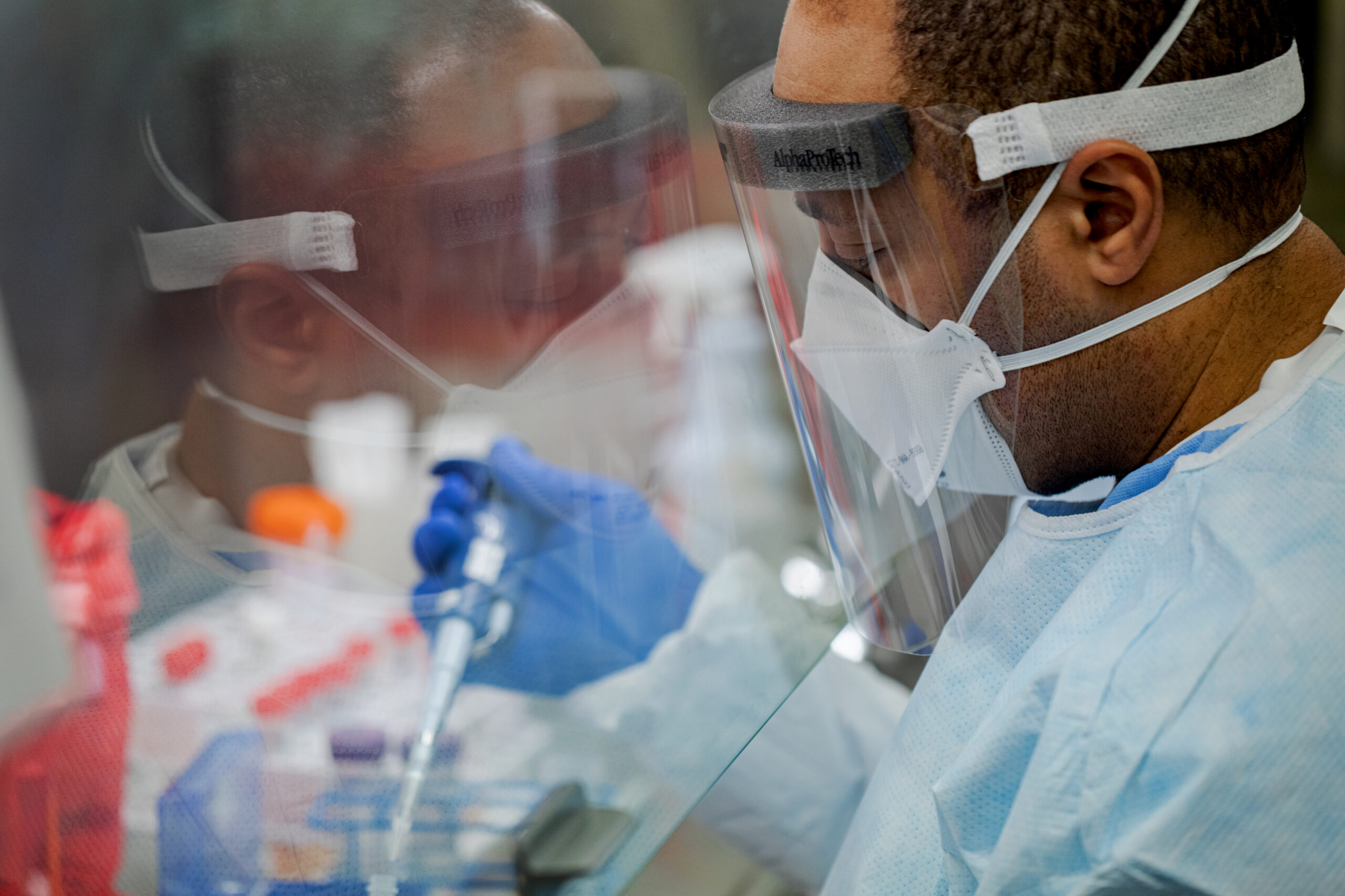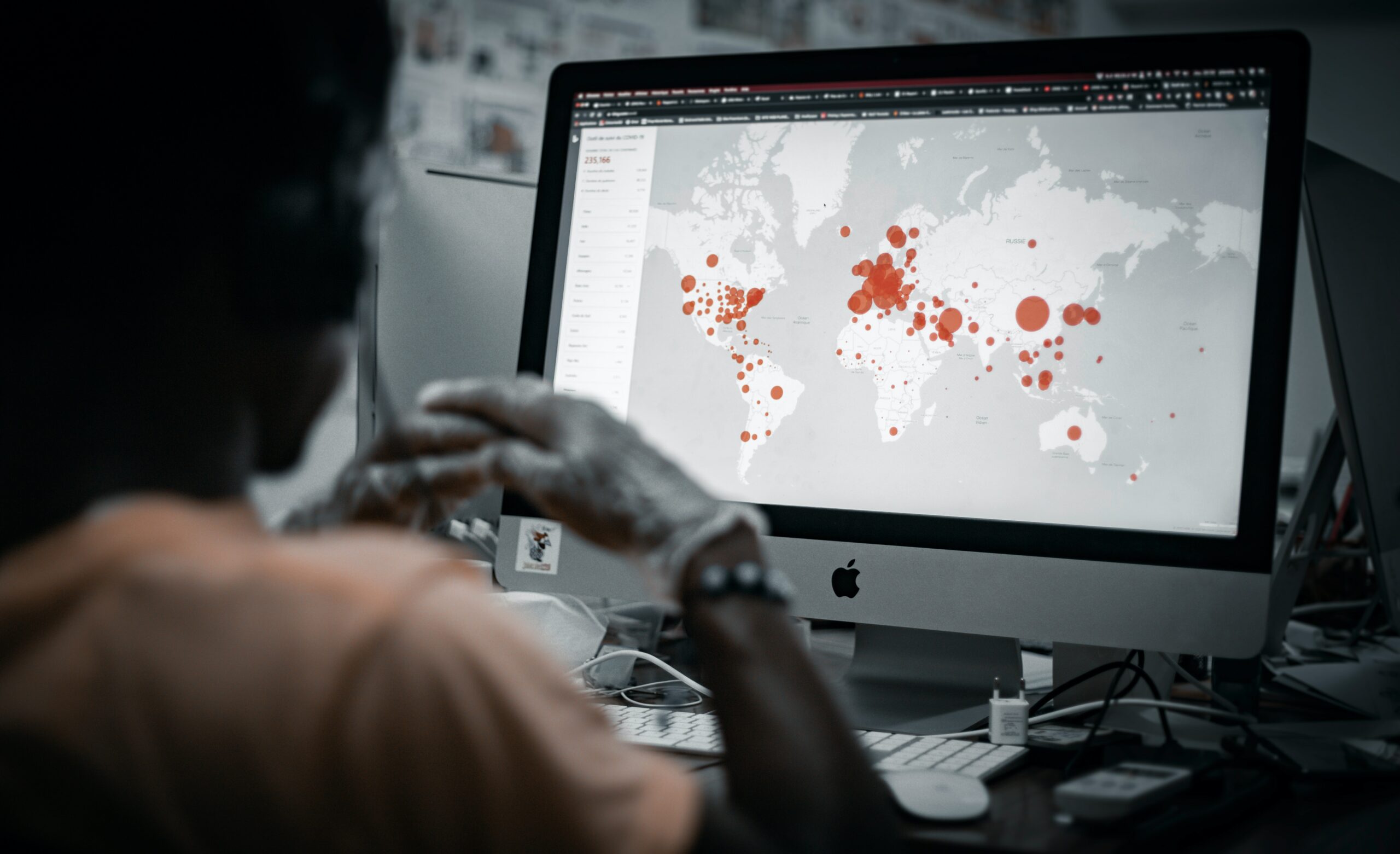
As Covid-19 took hold around the world, the scientific community had to match the virus in its transmission and mutations, which was made possible through honest and open collaboration. Researchers in China, where the virus first emerged, shared the decoded genome sequence within weeks of the first recorded case on an open discussion forum online. Within 24 hours, an evolutionary biologist in Scotland had found the similarities between this virus and SARS-CoV-1 and, like their Chinese colleagues, shared the findings online immediately.
From here, a researcher in the USA openly published the new virus’ phylogenetic tree, while another started reverse-engineering a live virus from the sequence, sharing their findings with colleagues around the world. Within just over a day, the scientific community had already made a huge step towards developing an antibody test to detect the virus. Digital technologies became the lifeblood of this dynamic form of scientific collaboration, with researchers and scientists jumping from Zoom call to Zoom call, and making extensive use of social media platforms, such as Twitter.
The social and economic fallout of the global pandemic is still shaping the global economy today, with outbreaks of the virus continuing to hamstring economic recoveries and the prospect of new and dangerous variants a constant concern. Yet, the response within the sciences to the challenges posed by the global pandemic at its onset was unprecedented, and has left a more positive legacy raising expectations of what can be achieved in a short period of time. The unprecedented speed, focus and scale of collaboration from the international scientific community showed what is possible when humanity works together towards a shared goal, and does so rapidly. As the epidemiologist, Neil Ferguson, puts it, “If it’s an important enough question, things can move very quickly”.

There were, of course, exceptions. The scientific push was dominated by scientists and scientific institutions based in the Global North, with many of the scientific community in the Global South excluded from the process. When breakthroughs occurred in the Global South, such as with Cuba’s rapid vaccine development, governments in the Global North were quick to turn their backs. The availability of vaccines also reflected the structures of global inequality, with only one in seven people in low income countries being fully vaccinated. This “vaccine apartheid” lead many countries in the Global South to take matters into their own hands.
Parallels to the scale and urgency of action required to tackle the climate crisis and the pandemic, and the dimensions of justice and equity between and within countries, are clear to see. And as the Rapid Transition Alliance has noted, the social response to the pandemic and the subsequent behaviour changes that followed are also of the type that may need to be adopted to radically and rapidly curtail global emissions. But understanding what enabled the radical and rapid transformation of the sciences is vital for scaling up efforts to understand and ultimately ameliorate the climate crisis.
Covid-19 changed the world we live in – and the way in which we do science. While the virus has, to date, claimed over 6.5 million lives worldwide, and more than 100 million people are still living with the effects of long covid, it has also transformed and massively accelerated the ability to find life saving cures.
Nothing escaped the impact of Covid-19. Globally, the virus led to a dramatic loss of life, up-ended some of the largest economies in the world, transformed the world of work and travel, and disordered the food systems and supply chains that billions depend upon. Beyond the immediate shifts triggered by Covid-19, the long-term societal changes are yet to be fully grasped.

The global pandemic laid bare many of the fissures within society, from the deficiencies in community care to a dearth of accessible green space. The impacts of Covid-19 were felt disproportionately by the most vulnerable in society, who could not afford to self-isolate or already lacked access to life’s basic needs. Structural inequalities were exposed within labour markets, housing markets and across demographics. These experiences will create social, economic and cultural effects that will endure.
As the tragedy unfolded, there were glimmers of different ways of living. From the reallocation of streetspace due to the fall in traffic and the exponential uptake of cycling to the pandemic epiphanies that many had after undertaking massive changes in their daily routines. Whether these revelations last is yet to be seen, but analysing, evaluating and remembering how they changed our perception of the world around us could be a vital tool in humanity’s fight against climate breakdown.
The sciences were the battlegrounds in which the global pandemic was fought. From proscribing social distancing, improving the mental health of adults and children amidst lockdowns, to laying the foundations for the creation of the various successful vaccines, it is deeply chilling to imagine where we would be now – and what horrors would have unfolded – if science had not been changed during the pandemic.
During the pandemic, science broke free. With a unified goal of slowing and eventually halting the spread of Covid-19, the scientific community tore down the established norms around doing research, collaborating across borders and time zones, publishing findings and engaging with governments and the public. Public trust in scientists mirrored Covid-19’s spread, with more than three-quarters of the global population saying they trust science (80 percent) and scientists (77 percent) either “a lot” or ”some”.
But how was science transformed and what enabled such dramatic changes to occur over a short period of time?
The speed, focus and collaboration of the scientific community in the face of the global pandemic was unprecedented in recent history. The scale of the crisis, and the speed at which it spread, meant that the scientific community had to reassess how science was done. Before the onset of Covid-19 the life sciences were relatively siloed, with experts working away in their respective fields, and publishing results in academic journals behind extensive paywalls that required lengthy and arduous peer review. With a virus spreading exponentially, and fear and uncertainty snowballing in its wake, this model of doing science was no longer fit for purpose.

The value of science in shaping and guiding the government response to the pandemic required upending the traditional peer-review process of academic publishing. Publishing reviews in some of the most respected journals is a competitive and highly prized honour that even the most famous scientists cherish. Before the onset of the pandemic, researchers and academics would willingly wait months and perhaps even years but the spread of the virus made different demands on the scientific community and the utility of research.
Researchers proactively shared preprint versions of their studies immediately after determining their results in the hopes that their discoveries would help other scientists further their own. Between December 2019 and November 2020, around 75,000 scientific papers were published on Covid-19, with one third published as preprints, released to other scientists and the public at large, before being fully reviewed and accepted for journal publication.
Similarly, the once lengthy lead-up times of clinical trials were totally transformed as health services and governments rushed to find drugs that would slow the spread or improve the survival rate of those hospitalised with Covid-19. Since 2000, the mean length of vaccine approval was around ten years from the start of clinical testing to approval. In the face of the rapidly spreading and mutating virus, this would not do. Just 11 months after the first SARS-CoV-2 sequence was published, three vaccines gained emergency-use authorization (EUA) or other forms of approval in Europe, the UK, and the USA. Before this remarkable roll-out, the fastest vaccine development was that for the mumps virus, which took four years from trial to approval in the 1960s.
Bypassing processes to speed up science was loaded with risks. In the spring of 2020, two influential scientific studies on Covid-19 were retracted on the grounds of data quality and a number of journals admitted that they needed to slow down the peer review process after the pandemic to ensure empirical quality. Likewise, the speed at which vaccines came into circulation fuelled anti-vaccine sentiment with concerns raised that vaccines were approved with many important steps skipped and with limited understanding of the long-term effects.

This pace and action-oriented approach was also reflected in the pace of policy change at government level. In the UK, within four hours of the release of the clinical trial of Dexamethasone, an anti-inflammatory drug used to treat those ill with Covid-19 in hospital, it became an NHS-backed public health policy. Such an immediate impact was unthinkable before the onset of the global pandemic, but now science was the shaping force of government policy.
This spirit of open collaboration within the scientific community has carried through – and shows no sign of waning. Almost immediately after the onset of the virus, Harvard Medical School pulled together over 20 Boston-area universities, medical schools and research institutes to launch the Massachusetts Consortium on Pathogen Readiness (MassCPR).
MassCPR scientists have gone on to write clinical management guidelines that have shaped patient care across the globe, and the consortium’s investigators have conceptualised, designed and developed the single-dose Johnson & Johnson vaccine and spearheaded clinical trials for the Moderna one. The traditional silos of academic research melted away in the face of such a monumental challenge, and collaborative coalitions like MassCPR continue to face down the greatest risks to public health today.
Funders and philanthropic organisations also took up this spirit of collaboration and sought to pool money, resources and expertise to scale solutions at pace. The Access to Covid-19 Tools (ACT) Accelerator and its vaccines pillar, COVAX, is a global philanthropic partnership launched by the World Health Organisation (WHO), the European Commission, France, and the Bill & Melinda Gates Foundation in April of 2020. The initiative scaled rapidly, with more than 170 countries representing 70 percent of humanity signalling their intent to join almost immediately. The founding principles of COVAX were deeply international, based on the recognition that no one is safe until everyone is and that the international community must come together to ensure equitable and simultaneous access to lifesaving treatments, rich or poor.

The pandemic also revived more grassroots and citizen-led scientific efforts, which is not to be mistaken with the ‘armchair epidemiologists’ of Twitter. As the world was forced to remain at home, with many unable to conduct their day-to-day jobs, some scientists and researchers turned their attention to the pandemic response. Climate science modellers and astrophysicists that were working from home began to use their statistical and scientific prowess to model transmission rates, the likelihood of new variants, and where the pandemic would take us next.
Seeing the impact that science had on the world and its response to the pandemic evoked a huge uptick in citizen science, where people without specialised training, working from home, began gathering data on everything from stars to insects. The citizen science platform, Zooniverse, which asks citizens to help classify animals in images from wildlife cameras saw its daily classifications jump from 25,000 to 200,000 per day. Zooniverse reported that 200,000 participants contributed more than 5 million classifications of images in just one week alone – the equivalent of 48 years of research.
Two of the key bio-technologies that combined to create the MRnA technology, which effectively teaches our cells how to make a protein, or even just a small piece of a protein, that then triggers an immune response inside our bodies, have been in the works for some time. The viral technology had humble beginnings and was conceived of by virologist Dr. Barney Graham, then working at Vanderbilt University in Nashville, Tennessee, over 40 years ago. The idea of the RNA modification, where elements of the RNA were modified to enable it to slip past the immune system undetected, was first tabled by Drew Weissman and Katalin Karikó at the University of Pennsylvania. When combined, these scientific discoveries laid the foundations for the MRnA technology and both research streams were funded entirely by the American federal government.
Across the Atlantic in the UK, the Oxford/AstraZeneca vaccine was 97 percent funded by the public through a combination of tax revenues and charitable donations. The same research found that just 2 percent of the funding for the Oxford/AstraZeneca actually came from private capital, directly contradicting former Prime Minister Boris Johnson’s claims that it was ‘greed and capitalism’ that ensured the creation of the vaccine. In fact, it was scientists trying to tackle some of the biggest challenges facing public health, working with their international colleagues and supported by the state, that laid the foundations for the vaccines.
This pattern played out elsewhere. In Cuba, a country that has had to innovate its biotech sector without access to US technology, a series of homegrown vaccines delivered up to 92.4 percent efficacy in clinical trials. The vaccine rollout has also been rapid too, with 89 percent of Cuba’s population — including children as young as 2 — receiving at least one dose of Soberana 02 or another Cuban vaccine called Abdala, by November 2021. The more coordinated, state-led and comprehensive response from Cuba – alongside its political philosophy – led to vastly different outcomes compared to the USA. Through July, 2021, the US cumulative case rate was more than 4 times higher than Cuba’s, while the death rate and excess death rate are both approximately 12 times higher in the USA.